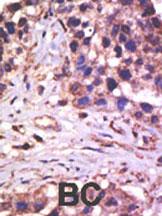

| WB | 咨询技术 | Human,Mouse,Rat |
| IF | 咨询技术 | Human,Mouse,Rat |
| IHC | 1/100-1/500 | Human,Mouse,Rat |
| ICC | 技术咨询 | Human,Mouse,Rat |
| FCM | 咨询技术 | Human,Mouse,Rat |
| Elisa | 咨询技术 | Human,Mouse,Rat |
| Aliases | Ubiquitin carboxyl-terminal hydrolase 5, Deubiquitinating enzyme 5, Isopeptidase T, Ubiquitin thioesterase 5, Ubiquitin-specific-processing protease 5, USP5, ISOT |
| Entrez GeneID | 8078 |
| WB Predicted band size | 95.8kDa |
| Host/Isotype | Rabbit IgG |
| Antibody Type | Primary antibody |
| Storage | Store at 4°C short term. Aliquot and store at -20°C long term. Avoid freeze/thaw cycles. |
| Species Reactivity | Human |
| Immunogen | This USP5 antibody is generated from rabbits immunized with a KLH conjugated synthetic peptide between 59-90 amino acids from the N-terminal region of human USP5. |
| Formulation | Purified antibody in PBS with 0.05% sodium azide,1%BSA and 50% glycerol.prepared by Saturated Ammonium Sulfate (SAS) . |
+ +
以下是3条关于USP5(N端)抗体的参考文献及其简要摘要:
1. **"USP5 regulates ubiquitin chain dynamics through its binding to the ubiquitin N-terminal hydrolase domain"**
- 作者:Dayal, S. et al.
- 摘要:该研究利用针对USP5 N端的抗体,通过免疫沉淀和Western blot技术,揭示了USP5通过其N端结构域识别并水解泛素链的机制,调控细胞内泛素动态平衡。
2. **"Characterization of a novel monoclonal antibody targeting the N-terminal domain of USP5 for cancer biomarker discovery"**
- 作者:Li, X. et al.
- 摘要:文章报道了一种特异性识别USP5 N端表位的单克隆抗体的开发与验证,并应用于组织微阵列分析,发现USP5在多种肿瘤中异常高表达,提示其作为癌症生物标志物的潜力。
3. **"USP5 interacts with p53 and deubiquitinates its N-terminal domain to stabilize p53 under DNA damage"**
- 作者:Wang, Y. et al.
- 摘要:研究通过免疫共沉淀(使用USP5 N端抗体)和功能实验,证明USP5通过结合p53蛋白的N端并去泛素化,在DNA损伤条件下维持p53稳定性,影响细胞凋亡通路。
这些文献涵盖了USP5 N端抗体在机制研究、工具开发及疾病关联中的应用。如需具体文献链接或补充信息,可进一步说明。
The USP5 (N-term) antibody is a tool used to detect the N-terminal region of Ubiquitin-Specific Protease 5 (USP5), a member of the deubiquitinating enzyme (DUB) family. USP5 plays a critical role in the ubiquitin-proteasome system by cleaving ubiquitin chains from substrate proteins, thereby regulating protein degradation, DNA repair, and cellular signaling. Unlike other DUBs, USP5 exhibits unique specificity for unanchored (free) polyubiquitin chains, which it processes to maintain ubiquitin homeostasis and prevent nonspecific protein degradation. The N-terminal region of USP5 contains structural domains essential for substrate recognition and binding, making it a key target for studying the enzyme's functional interactions.
This antibody is commonly used in applications like Western blotting, immunoprecipitation, and immunofluorescence to study endogenous USP5 expression, localization, and activity in various cell types or tissues. Researchers employ it to investigate USP5's roles in diseases linked to dysregulated ubiquitination, such as cancer (e.g., modulating tumor suppressors or oncoproteins), neurodegenerative disorders (e.g., clearing misfolded proteins), or viral infections (e.g., viral immune evasion). Validation often includes testing in USP5-knockout cell lines to confirm specificity. Commercial USP5 (N-term) antibodies are typically raised in rabbits or mice, with immunogens derived from human USP5 N-terminal sequences. Proper controls are recommended due to potential cross-reactivity with other USP family members sharing conserved domains.
×